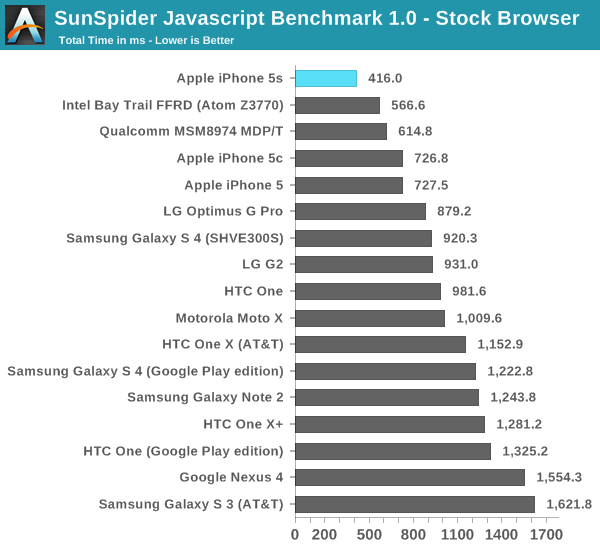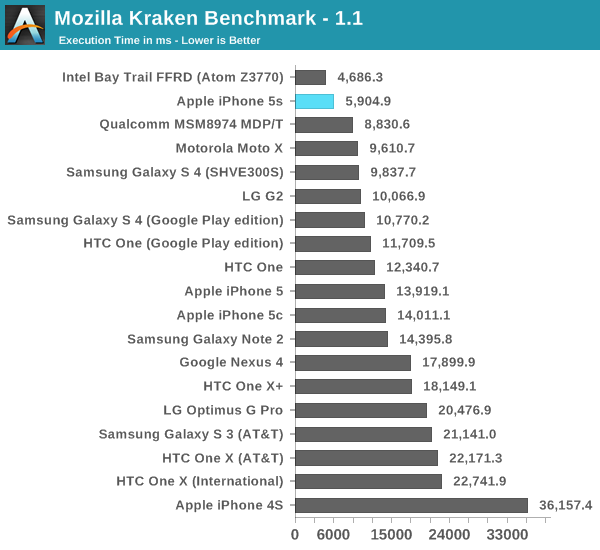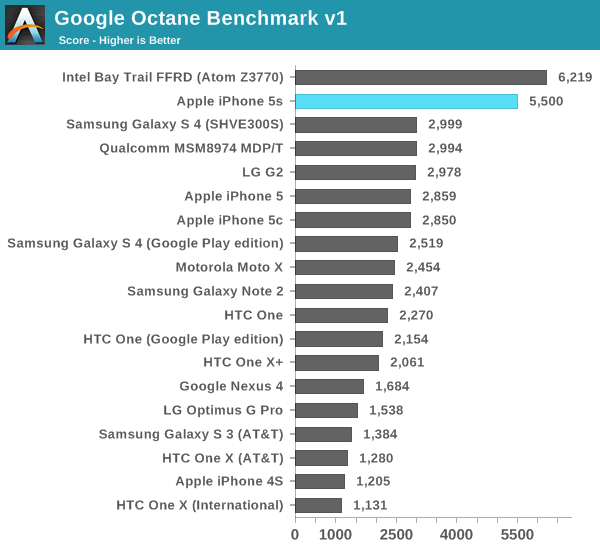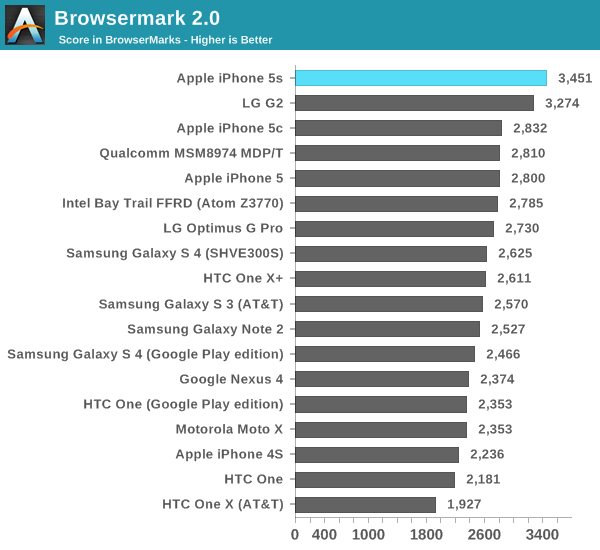The iPhone 5s Review
by Anand Lal Shimpi on September 17, 2013 9:01 PM EST- Posted in
- Smartphones
- Apple
- Mobile
- iPhone
- iPhone 5S
CPU Performance
For our cross-platform CPU performance tests we turn to the usual collection of Javascript and HTML5 based browser tests. Most of our comparison targets here are smartphones with two exceptions: Intel's Bay Trail FFRD and Qualcomm's MSM8974 Snapdragon 800 MDP/T. Both of those platforms are test tablets, leveraging higher TDP silicon in a tablet form factor. The gap between the TDP of Apple's A7 and those two SoCs isn't huge, but there is a gap. I only include those platforms as a reference point. As you're about to see, the work that Apple has put into the A7 makes the iPhone 5s performance competitive with both. In many cases the A7 delivers better performance than one or both of them. A truly competitive A7 here also gives an early indication of the baseline to expect from the next-generation iPad.
We start with SunSpider's latest iteration, measuring the performance of the browser's js engine as well as the underlying hardware. It's possible to get good performance gains by exploiting advantages in both hardware and software here. As of late SunSpider has turned into a bit of a serious optimization target for all browser and hardware vendors, but it can be a good measure of an improving memory subsystem assuming the software doesn't get in the way of the hardware.

Bay Trail's performance crown lasted all of a week, and even less than that if you count when we actually ran this benchmark. The dual-core A7 is now the fastest SoC we've tested under SunSpider, even outpacing Qualcomm's Snapdragon 800 and ARM's Cortex A15. Apple doesn't quite hit the 2x increase in CPU performance here, but it's very close at a 75% perf increase compared to the iPhone 5. Update: Intel responded with a Bay Trail run under IE11, which comes in at 329.6 ms.
Next up is Kraken, a heavier js benchmark designed to stress more forward looking algorithms. Once again we run the risk of the benchmark becoming an optimization target, but in the case of Kraken I haven't seen too much attention paid to it. I hope it continues to fly under the radar as I've liked it as a benchmark thus far.

The A7 falls second only to Intel's Atom Z3770. Although I haven't yet published these results, the 5s performs very similarly to an Atom Z3740 - a more modestly clocked Bay Trail SKU from Intel. Given the relatively low CPU frequency I'm not at all surprised that the A7 can't compete with the fastest Bay Trail but instead is better matched for a middle of the road SKU. Either way, A7's performance here is downright amazing. Once again there's a performance advantage over Snapdragon 800 and Cortex A15, both running at much higher peak frequencies (and likely higher power levels too, although that's speculation until we can tear down an S800 platform and a 5s to compare).
Compared to the iPhone 5, the 5s shows up at over 2.3x the speed of last year's flagship.
Next up is Google's Octane benchmark, yet another js test but this time really used as a design target for Google's own V8 js engine. Devices that can run Chrome tend to do the best here, potentially putting the 5s at a disadvantage.

Bay Trail takes the lead here once again, but again I expect the Z3740 to be a closer match for the A7 in the 5s at least (it remains to be seen how high the iPad 5 version of Cyclone will be clocked). The performance advantage over the iPhone 5 is a staggering 92%, and obviously there are big gains over all of the competing ARM based CPU architectures. Apple is benefitting slightly from Mobile Safari being a 64-bit binary, however I don't know if it's actually getting any benefit other than access to increased register space.
Our final browser test is arguably the most interesting. Rather than focusing on js code snippets, Browsermark 2.0 attempts to be a more holistic browser benchmark. The result is much less peaky performance and a better view at the sort of moderate gains you'd see in actual usage.

There's a fair amount of clustering around 2500 with very little differentiation between a lot of the devices. The unique standouts are the Snapdragon 800 based G2 from LG, and of course the iPhone 5s. Here we see the most modest example of the A7's performance superiority at roughly 25% better than the iPhone 5. Not to understate the performance of the iPhone 5s, but depending on workload you'll see a wide range of performance improvements.










464 Comments
View All Comments
ShAdOwXPR - Wednesday, September 18, 2013 - link
A7X win be a monster 130-150 GFLOPS that's Xbox 360 territory. Apple saying the A7 is a desktop class might be real with the benchmark numbers of the A7X...darkich - Thursday, September 19, 2013 - link
I expect the GPU on A7X to be even more impressive, approaching 200GFLOPS and easily beating the PS3/XBOX 360 in terms of graphical ability because of far more capable memory.It should be at least on par with the Intel HD 4000 at the fraction of TDP
AaronJ68 - Wednesday, September 18, 2013 - link
I only scanned the review, as I have a few things to do this afternoon. But tonight, during the baseball game, I plan on detailed read-through. Thank you.On the other side of the coin, iTunes Radio just played a Ke$ha song ... so ... :)
Onemanbucket - Wednesday, September 18, 2013 - link
Anand,I signed up here just to say that is the best, most educated review I have ever read. I was swaying between iPhone 5S and a Windows device (925) but your clear enthusiasm for the technology her has swung it.
Cheers.
Jumangi - Wednesday, September 18, 2013 - link
The advanced SoC is one part of making a quality day to day phone. Apple sticking to a tiny 4' screen in 2013 should be called out as unacceptable from any enthusiast site like Anandtech.beggerking@yahoo.com - Wednesday, September 18, 2013 - link
only 2 core...any multithreaded benchmark comparison vs typical Android quad cores?kinshadow - Wednesday, September 18, 2013 - link
What made you guess the 6430 over the 6400? I don't see anything in the article that really points either way.Gorgenapper - Wednesday, September 18, 2013 - link
Recently switched from an iPhone 4S to a Galaxy S4 Active. Two observations....with regards to what Anand said about iPhone users switching out of frustration:1) I would have been happy with a 4.5" ~ 4.7" screen on an iPhone. The IPS LCD panels on the iPhones are of the best quality and calibration in the industry, with the HTC One's screen coming a very close second place (not sure about the LG G2's, never seen one in person). But a 4" screen is too small, let alone the 3.5" screen on my iPhone 4S, and I just got sick of waiting for Apple to wake up.
2) iTunes
I can see #1 coming true when the iPhone 6 is up next, but #2 will never change.
darkcrayon - Wednesday, September 18, 2013 - link
And you need iTunes for what on a daily basis? That's a plus IMO, I like having an easy option for disk based backups and sync to multiple devices. I use it on Mac OS X though.Gorgenapper - Wednesday, September 18, 2013 - link
I'm on a pc.1) iTunes forces me to keep a separate folder structure for pictures, as I have many high res pics, zip files, rar files that would get synced regardless. I have to maintain the pics in this folder as well as those in my main picture folder(s).
2) Movies on the device are inextricably linked to those on the iTunes library, I can't manually get those movies off the device even if I accidentally wiped out the movies on my computer.
3) Kind of iTunes related (locked down filesystem), but the Camera Roll on my device stores the pictures in randomly-named folders, and they're all generically named IMG_****. It's a real pain to find and extract photos using Windows Explorer.
4) I can't use any free space on the phone to transport files like a USB drive (minor issue)
5) iTunes is slow to boot up, and the interface is not as intuitive (to me) as a simple Windows Explorer window.
6) I have often run into a problem where I manually delete a movie off my iPhone to make room for shooting video, then go to resync it and iTunes doesn't realize that the movie is missing - I have to unsync all the movies that are currently on the iPhone, then resync them all to get that movie back.